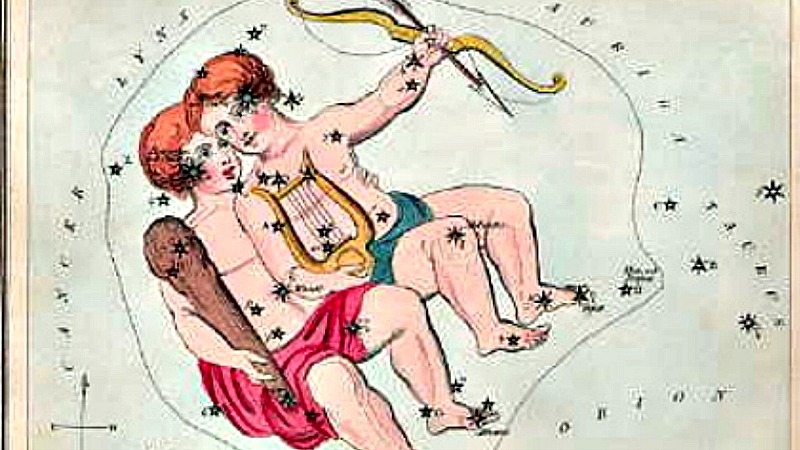
On December 23 and 24, 2018, the waning gibbous moon – just past the solstice full moon – passes to the south of the two brightest stars of the constellation Gemini. These two stars are noticeable for being bright and close together. In sky lore, they represent the starry eyes of twin brothers. One star is Castor, and the other is Pollux. On these nights, the moon is also passing to the north of Procyon, the Little Dog Star.
As it goes full circle in front of the constellations of the zodiac, the moon swings in between the Gemini stars and Procyon once every sidereal month. But these stars aren’t always so well-placed for viewing as they are now!
Click here for recommended almanacs that’ll tell you the rising time of the moon in your sky. And to find out the rising times for Castor, Pollux and Procyon (plus other bright stars), click here.
Castor and Pollux might look meek in the moonlit glare these next couple of nights. But they’re among our sky’s brightest stars. How can you find them when the moon has moved away Here’s one way. Are you familiar with Orion the Hunter, one of the most noticeable of all constellations? If so, you can star-hop from Orion to the constellation Gemini on a dark, moonless night.
Orion’s Belt is the most noticeable part of the constellation. It consists of three stars in a short, straight row. As depicted in the sky chart below, draw an imaginary line from Mintaka, the westernmost star of Orion’s Belt, through the bright ruddy star Betelgeuse. That line will take you to Gemini.
At mid-northern latitudes, Orion and Gemnini rise at approximately the same time. At more southerly latitudes, like those in the Southern Hemisphere, Orion rises before Gemini. But no matter where you live worldwide – once the moon has moved to another part of the sky – Orion can serve as your ticket to locating the constellation Gemini the Twins.

Star-hop to the constellation Gemini by drawing an imaginary line from Orion’s Belt through the bright ruddy star Betelgeuse.
Bottom line: On December 23, 2018, the moon is in front of the constellation Gemini, near its brightest stars Castor and Pollux. The next night, December 24, you’ll find the moon farther from these stars but still near enough to help you find them.
from EarthSky http://bit.ly/2RfTTdI

On December 23 and 24, 2018, the waning gibbous moon – just past the solstice full moon – passes to the south of the two brightest stars of the constellation Gemini. These two stars are noticeable for being bright and close together. In sky lore, they represent the starry eyes of twin brothers. One star is Castor, and the other is Pollux. On these nights, the moon is also passing to the north of Procyon, the Little Dog Star.
As it goes full circle in front of the constellations of the zodiac, the moon swings in between the Gemini stars and Procyon once every sidereal month. But these stars aren’t always so well-placed for viewing as they are now!
Click here for recommended almanacs that’ll tell you the rising time of the moon in your sky. And to find out the rising times for Castor, Pollux and Procyon (plus other bright stars), click here.
Castor and Pollux might look meek in the moonlit glare these next couple of nights. But they’re among our sky’s brightest stars. How can you find them when the moon has moved away Here’s one way. Are you familiar with Orion the Hunter, one of the most noticeable of all constellations? If so, you can star-hop from Orion to the constellation Gemini on a dark, moonless night.
Orion’s Belt is the most noticeable part of the constellation. It consists of three stars in a short, straight row. As depicted in the sky chart below, draw an imaginary line from Mintaka, the westernmost star of Orion’s Belt, through the bright ruddy star Betelgeuse. That line will take you to Gemini.
At mid-northern latitudes, Orion and Gemnini rise at approximately the same time. At more southerly latitudes, like those in the Southern Hemisphere, Orion rises before Gemini. But no matter where you live worldwide – once the moon has moved to another part of the sky – Orion can serve as your ticket to locating the constellation Gemini the Twins.

Star-hop to the constellation Gemini by drawing an imaginary line from Orion’s Belt through the bright ruddy star Betelgeuse.
Bottom line: On December 23, 2018, the moon is in front of the constellation Gemini, near its brightest stars Castor and Pollux. The next night, December 24, you’ll find the moon farther from these stars but still near enough to help you find them.
from EarthSky http://bit.ly/2RfTTdI


Aucun commentaire:
Enregistrer un commentaire